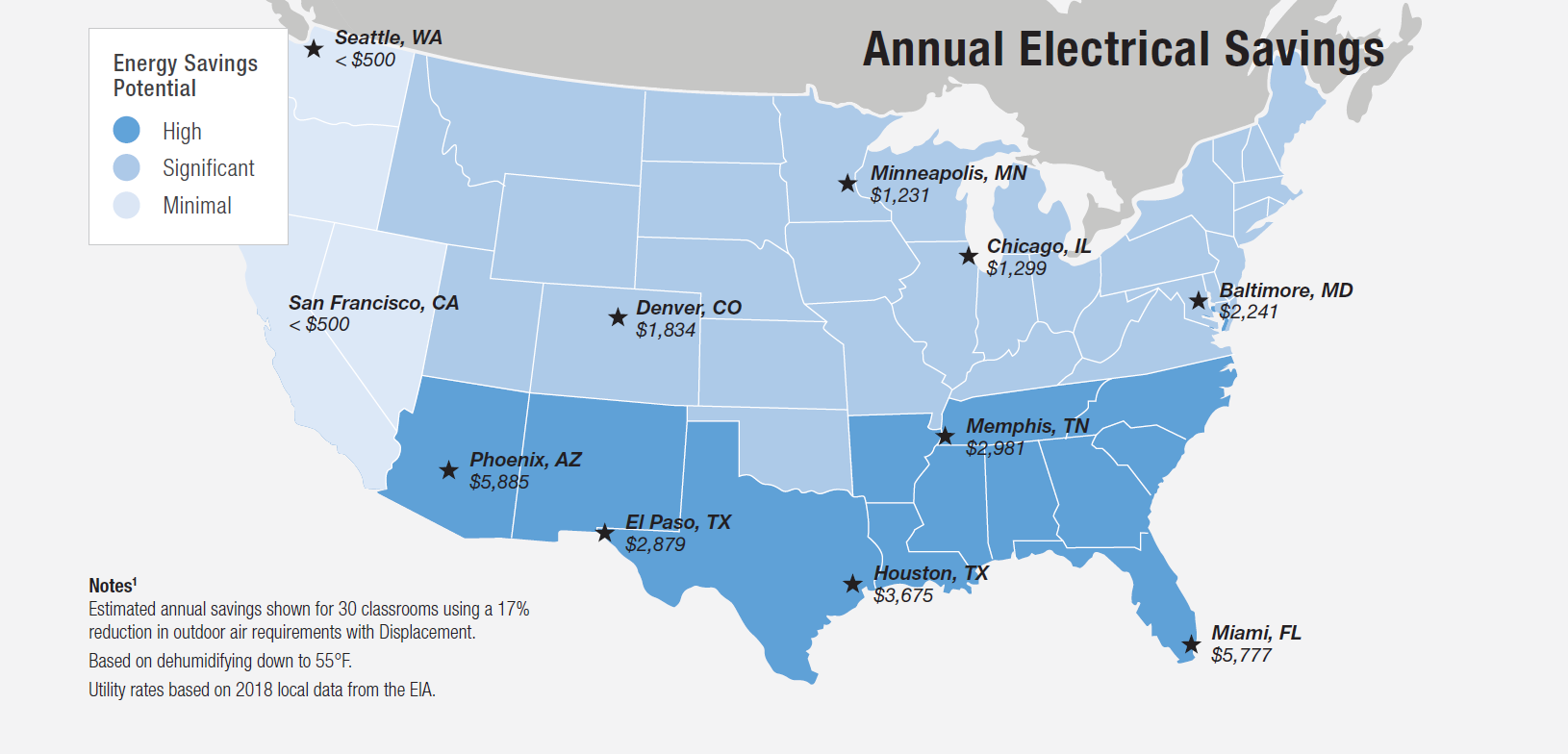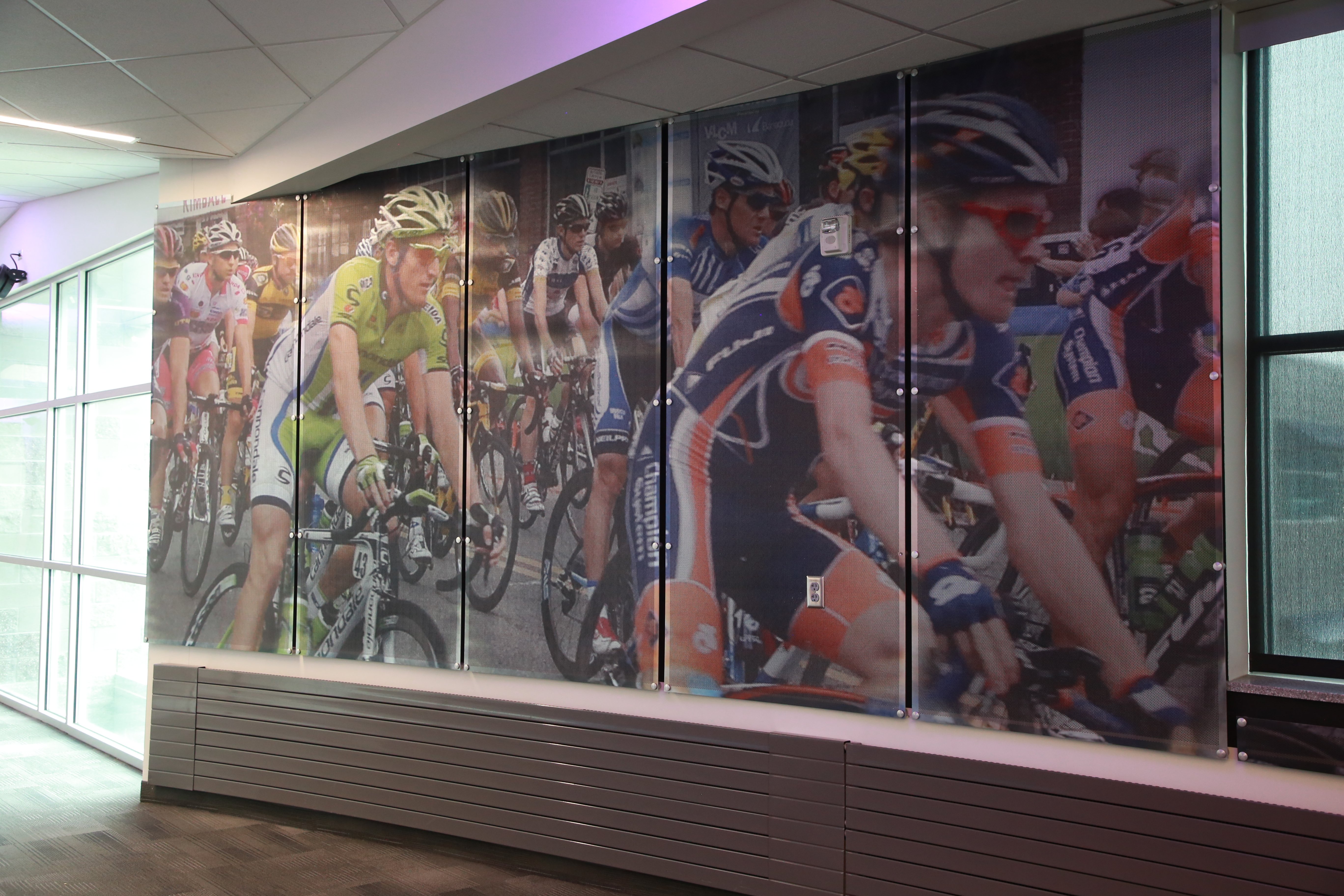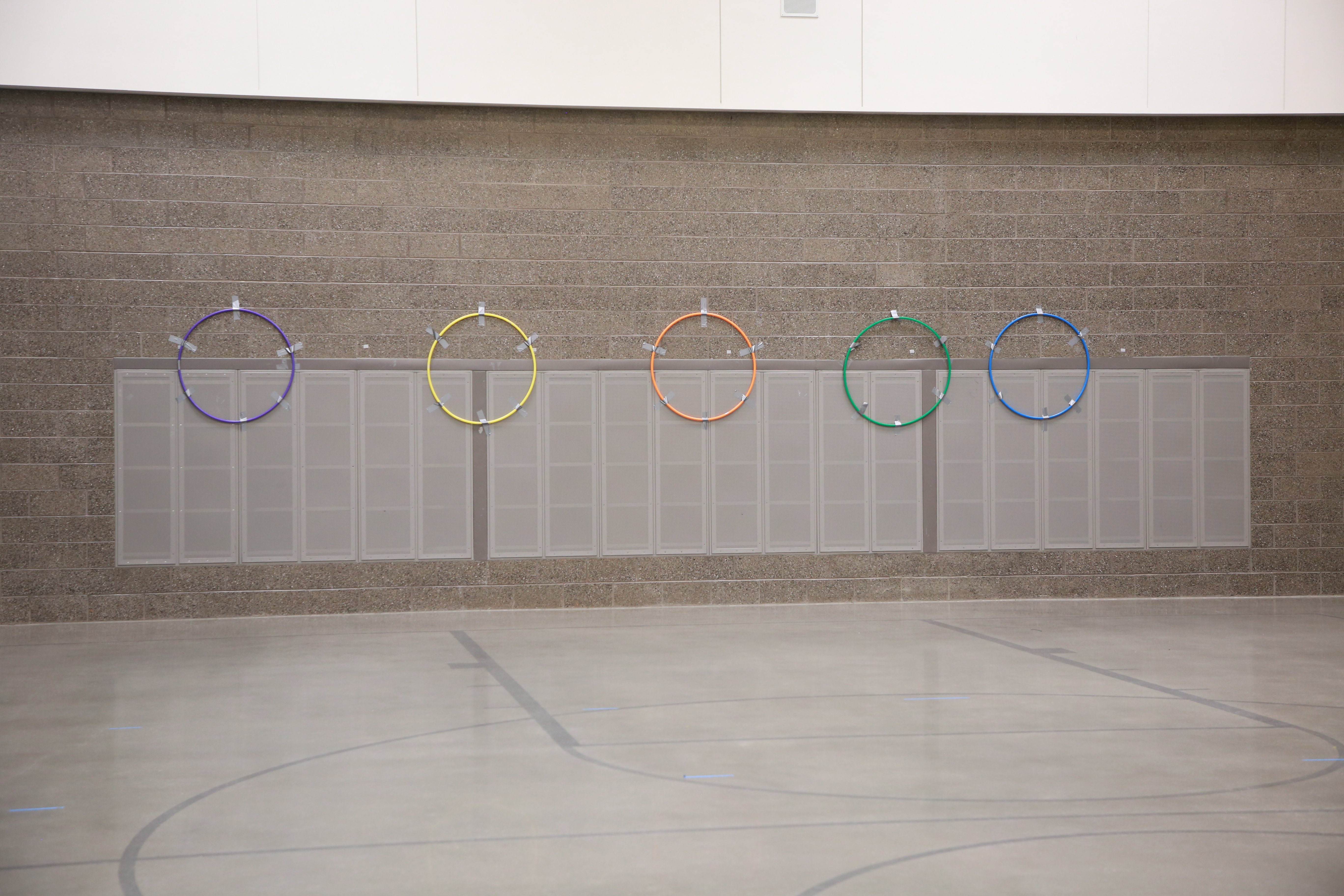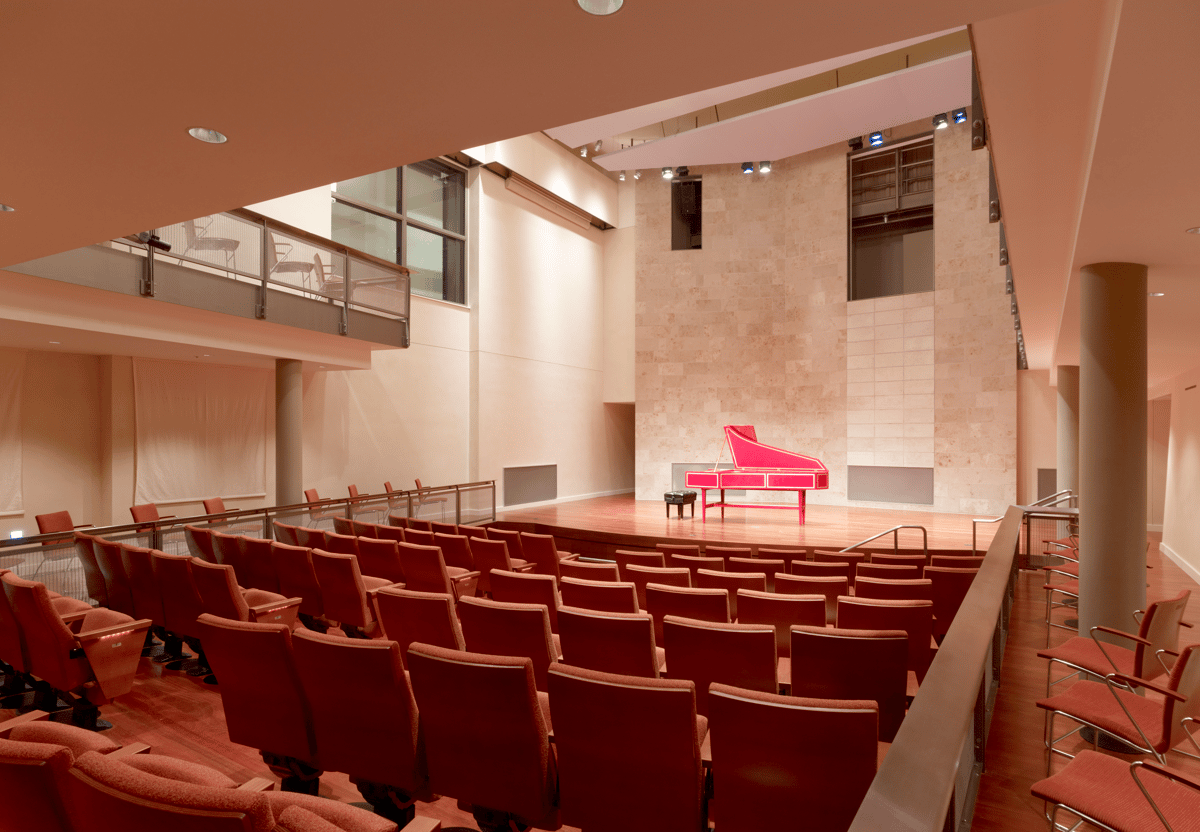Energy Efficient Ventilation Effectiveness and Thermal Comfort
Displacement ventilation provides low velocity air at around 65°F that relies on buoyancy forces to drive the air motion. Supply air spreads across the floor until encountering thermal plumes from heat sources that naturally drive the clean, conditioned air up through the breathing zone. Heat and particulate are carried up to high-level return or exhaust grilles instead of getting recycled through the space. The result is high ventilation effectiveness and improved thermal comfort delivered in an energy efficient manner.

Displacement Compared to Mixed Air Systems

Common Applications - High Ceilings
Displacement ventilation creates a stratified environment that can greatly benefit high ceiling areas and reduce airflow requirements for the space. Diffusers can be uniquely integrated into the structure through the floor or walls to lend additional flexibility to the architectural design of the space.

Auditoriums - Kauffman Center for Performing Arts
Common Applications - High Occupancy
![[082] 8779v3](https://blog.priceindustries.com/hs-fs/hubfs/%5B082%5D%208779v3.jpg?width=2450&name=%5B082%5D%208779v3.jpg)
Schools - Montgomery Middle School
Benefits of Displacement Ventilation
1. Energy Savings
Increased Free Cooling Hours

Reduced Outdoor Air Requirement
| Air Supply Method | Ez (ASHRAE 62.1) |
| Mixed - Heating | 0.8 - 1.0 |
| Mixed - Cooling | 1.0 |
| Displacement | 1.2 |
Value summarized from ASHRAE 62.1 2013, Table 6.2.2.2
| Mixing | Displacement |
|
VOZ,M = Vbz / EZ,M = Vbz / 1.0 = Vbz |
VOZ,DV = Vbz / EZ,DV = Vbz / 1.2 = 0.83 Vbz = 17% Reduction in outdoor air requirement |
Reducing the ventilation rate can translate to significant energy savings in hot and humid climates.

2. Increased Indoor Environmental Quality
Superior Indoor Air Quality
The Environmental Protection Agency (EPA) suggests schools investigate using displacement ventilation: “Designers should investigate a method called vertical displacement ventilation or thermal displacement ventilation. This approach successfully uses natural convection forces to reduce fan energy and carefully lift air contaminants up and away from the breathing zone.”2
Many studies claim large improvements in air quality with Displacement Ventilation.
- Classroom study with DV shows 17% – 27% lower peak CO2 levels in the breathing zone than the control space with a mixed air system.3
- ASHRAE recognizes a minimum 20% improvement in air quality.4
- Spaces using Displacement resulted in 25% – 90% better air quality than spaces using overhead mixing air systems.5
- A two year study in 12 schools retrofitted with DV reported a reduction in reported asthmatic symptoms by 69%.6

Several independent studies have analyzed the impact of CO2 and Indoor Air Quality on occupant performance and health.
- A 400 ppm increase in CO2 resulted in a 21% decrease in cognitive scores.7
- An increase in CO2 levels correlated to an increase in health symptoms and a reduction in performance.8
- Higher CO2 concentrations were associated with an increase of wheezing attacks in children.9
Indoor air quality studies reveal high CO2 levels in U.S. classrooms throughout the country.
- One Texas study10 that reviewed 120 randomly selected classrooms with unit ventilators and heat pumps found that:
- 88% exceeded 1,000 ppm peak CO2 concentrations
- 22% and 54% had 3,000 ppm and 2,000 ppm peak CO2 levels respectively.
- Similar trends were identified in a Washington and Idaho study.11 This study also noted that:
- A 1,000 ppm increase in space CO2 corresponded to a 10% – 20% increase in student absence.
High Thermal Comfort
Displacement Ventilation supplies air at a low face velocity (typically 40 fpm) into the occupied zone and at a temperature around 10°F cooler than the set point. The increase in supply air temperature combined with the low velocity airflow results in superior thermal comfort.
Improved Acoustics
The displacement system creates a quiet environment due to the low velocity air introduced into the space. Lower noise levels are advantageous for spaces such as classrooms, offices, auditoriums, libraries and other noise critical areas. One classroom study noted an 8 dBA reduction in sound level by using a displacement air flow in comparison to a classroom nearby that used a mixed air ceiling system.3
3. Reduced Maintenance
Application in Focus - Schools
EPA suggests central AHUs instead of unit ventilators to minimize health and maintenance issues12
“It is more difficult to assure proper maintenance of multiple units over time and they [unit ventilators] present additional opportunities for moisture problems through wall penetrations and from drain pan and discharge problems.”The EPA states that “maintenance issues can lead to lower Average Daily Attendance (ADA)” which is used as a metric for acquiring federal funding in a number of states. Displacement Ventilation contains similar mechanical components to an overhead VAV mixed air system but simply delivers the air into the space in a more efficient manner.

4. Architectural Integration
- Can be integrated into structure and furniture elements to free up ceiling space.
- Available in various colors, sizes and custom finishes, seamlessly integrating into any space.
- Special mounting options, inlet locations, and integrated utilities.
- Heavy-duty construction available for high traffic areas such as gyms, schools, and industrial settings.

.jpg?width=600&name=IMG_2110%20(Medium).jpg)


References
1. Table 5.6.A. Average Price Of Electricity To Ultimate Customers By End-Use Sector, By State, February 2018 And 2017 (Cents Per Kilowatthour). U.S. Energy Information Administration. N.p., 2018. Web. 4 May 2018.
2. “Heating, Ventilation And Air-Conditioning Systems, Part Of Indoor Air Quality Design Tools For Schools | US EPA.” US EPA. N.p., 2018. Web.
3. Arent, J., Eley, C., & Meister, B. (2006). Displacement Ventilation in Action: Performance Monitoring of Demonstration Classrooms. ACEE Summer Study on Energy Efficiency in Buildings.
4. ASHRAE Standard 62.1 – 2013. Ventilation for Acceptable Indoor Air Quality.
5. Jung, A., and M. Zeller, 2005. Analysis and Testing of Methods to Determine Indoor Air Quality and Air Change Effectiveness. Original technical paper from Rheinisch-Westfälische Technical University of Aachen, Germany, 1994.
6. Smedje, G., & Norback, D. (2000). New Ventilation Systems at Select Schools in Sweden - Effects on Asthma and Exposure.
7. Allen, J. G., & al., e. (2015). Associations of Cognitive Function Scores with CO2, Ventilation and VOC Exposures in Office Workers; A Controlled Exposure Study of Green and Conventional Office
8. Myhrvold, A.N., Olsen, E. and Lauridsen, O. (1996) Indoor environment in schools -pupils health and performance in regard to CO2 concentrations. Proceedings of Indoor Air ’96: The 7th International Conference on Indoor Air Quality and Climate, Nagoya, Japan, July, 1996, Vol. 4, 369–374.
9. Kim, C. S., Lim, Y. W., Yang, J. Y., Hong, C. S., and Shin, D. C., (2002) Effect of Indoor CO2 concentrations on Wheezing Attacks in Children. Indoor Air ‘02: Proceedings of the 9th International Conference on Indoor Air Quality and Climate.
10.Corsi, R., Torres, V., Sanders, M., & Kinney, K. (2002). Carbon Dioxide Levels and Dynamics in Elementary Schools: Results of the TESIAS Study. Indoor Air.
11.Shendell, D., Prill, R., Fisk, W., Apte, M., Blake, D., & Faulkner, D. (2004). Associations Between Classroom CO2 Concentrations and Student Attendance in Washington and Idaho. Indoor Air.
12.Heating, Ventilation and Air-Conditioning Systems, Part of Indoor Air Quality Design Tools for Schools (2017). Retrieved from United States Environmental Protection Agency. https://www.epa.gov/iaq-schools/heating-ventilation-and-air-conditioning-systems-part-indoor-air-quality-design-tools#SelectionofHVACEquipment



